Book contents
- Frontmatter
- Contents
- List of Figures
- List of Maps
- List of Tables
- Preface
- Acknowledgments
- List of Abbreviations
- Note on Transcription
- Introduction: languages, contexts, and constructs
- Part 1 Language history, families, and typology
- Part 2 Languages and their functions
- Part 3 Sanskrit and traditions of language study
- Part 4 Multilingualism, contact, and convergence
- Part 5 Orality, literacy, and writing systems
- Part 6 Language conflicts
- 15 Language politics and conflicts in South Asia
- Part 7 Language and modernization
- Part 8 Language and discourse
- Part 9 Language and identity
- Part 10 Languages in diaspora
- References
- Subject Index
- Language Index
- Author Index
15 - Language politics and conflicts in South Asia
Published online by Cambridge University Press: 04 May 2010
- Frontmatter
- Contents
- List of Figures
- List of Maps
- List of Tables
- Preface
- Acknowledgments
- List of Abbreviations
- Note on Transcription
- Introduction: languages, contexts, and constructs
- Part 1 Language history, families, and typology
- Part 2 Languages and their functions
- Part 3 Sanskrit and traditions of language study
- Part 4 Multilingualism, contact, and convergence
- Part 5 Orality, literacy, and writing systems
- Part 6 Language conflicts
- 15 Language politics and conflicts in South Asia
- Part 7 Language and modernization
- Part 8 Language and discourse
- Part 9 Language and identity
- Part 10 Languages in diaspora
- References
- Subject Index
- Language Index
- Author Index
Summary
Introduction
It is assumed here that South Asia consists of the seven sovereign nations of the subcontinent belonging to the loosely grouped organization SAARC (South Asian Association for Regional Cooperation): Bangladesh, Bhutan, India, the Maldives, Nepal, Pakistan, and Sri Lanka (Breton 1997: 16). Afghanistan is a special case, sitting squarely astride the divide between the Middle East and South Asia and drawing in about equal measure from each in culture and history, and I have chosen to leave it out of consideration here for space reasons. (For wide-ranging theoretical discussions of the problems involved in defining such concepts as “South Asia” and “India,” see Emeneau 1980; Masica 1976; Roy 1985; and Sopher 1980).
It is useful to begin this chapter by asking the question: what are the ingredients that lead to language conflicts and language as a political concern? Obviously we cannot identify precisely those specifics about countries or regions that are necessary and sufficient conditions for language to become a political issue, for language politics is not an exact science. However, it is not difficult to identify recurrent factors for predicting language conflict in a country or region.
First, there should be more than one language (or dialect) competing for political, economic, and cultural “space.” The larger the number of languages, the greater the likelihood that language will become a worrisome political issue.
- Type
- Chapter
- Information
- Language in South Asia , pp. 311 - 324Publisher: Cambridge University PressPrint publication year: 2008
- 1
- Cited by



